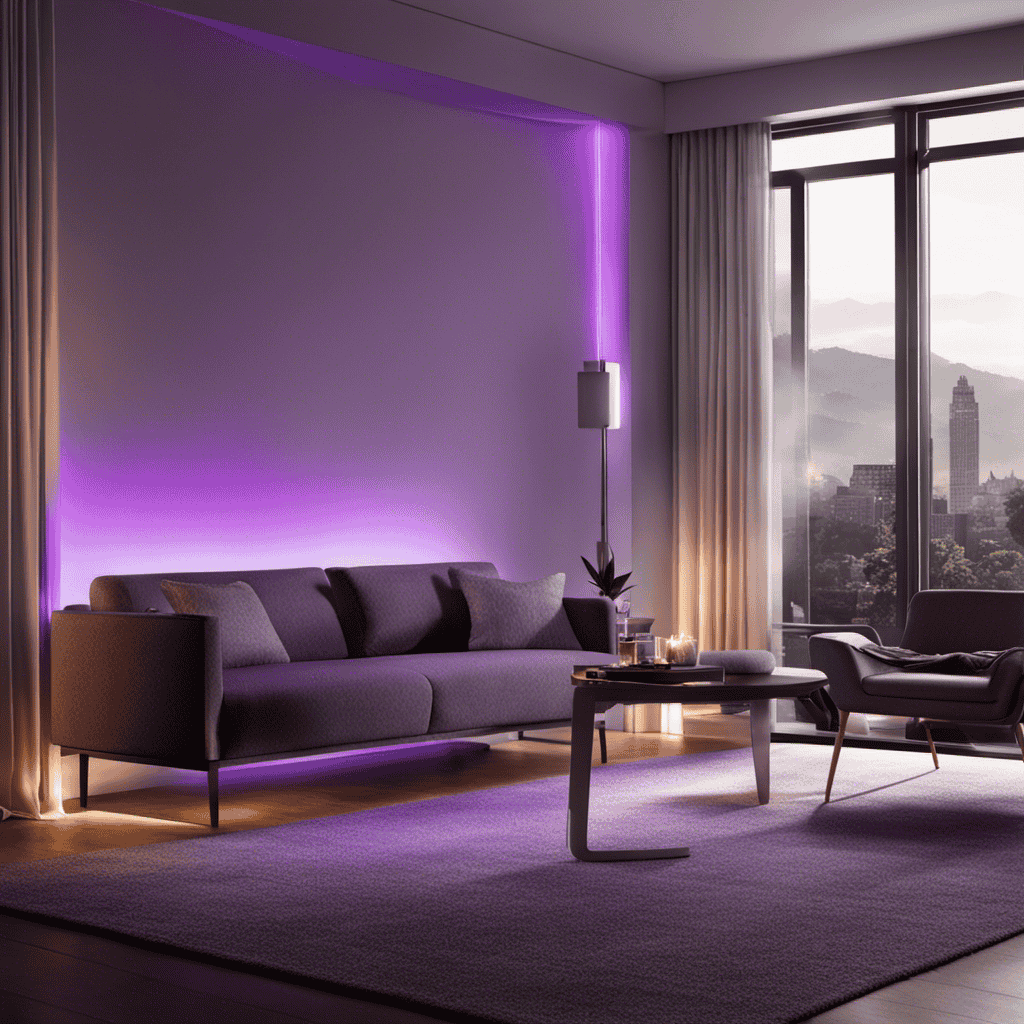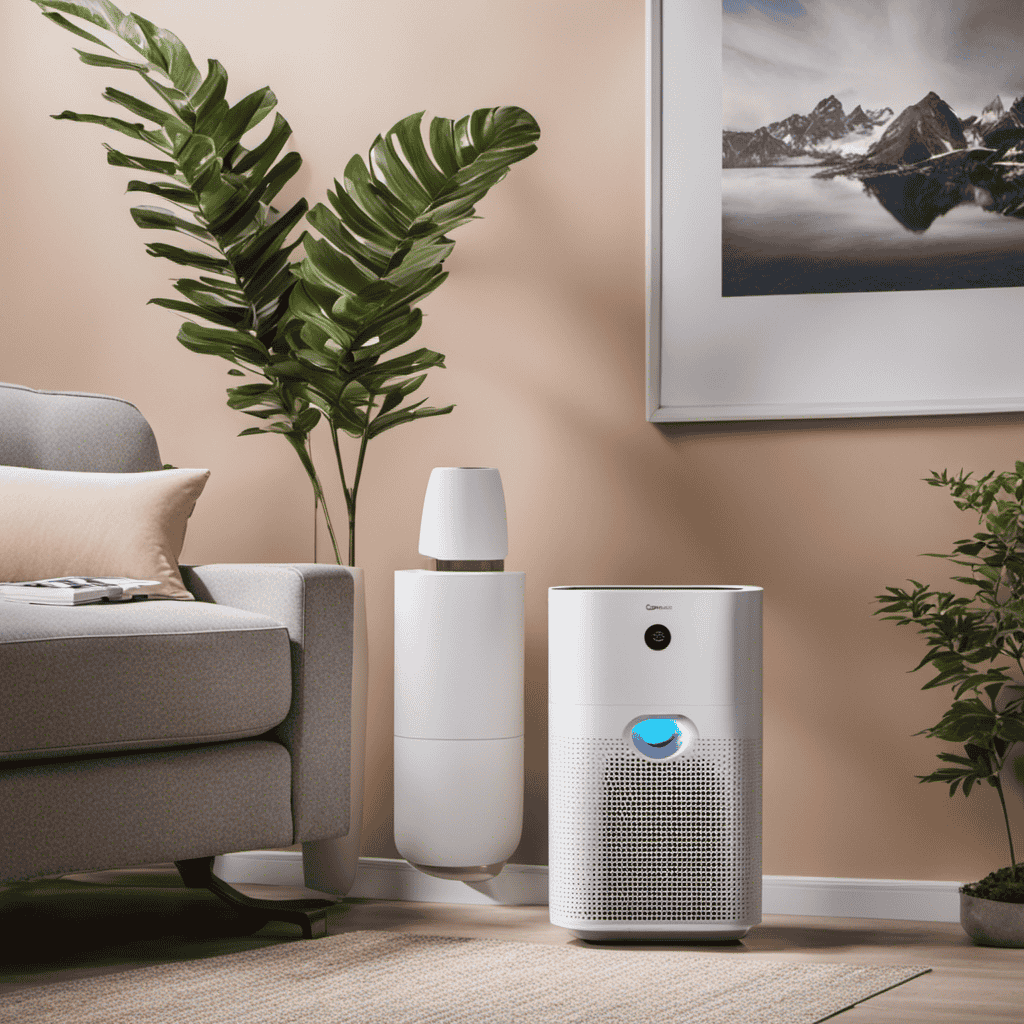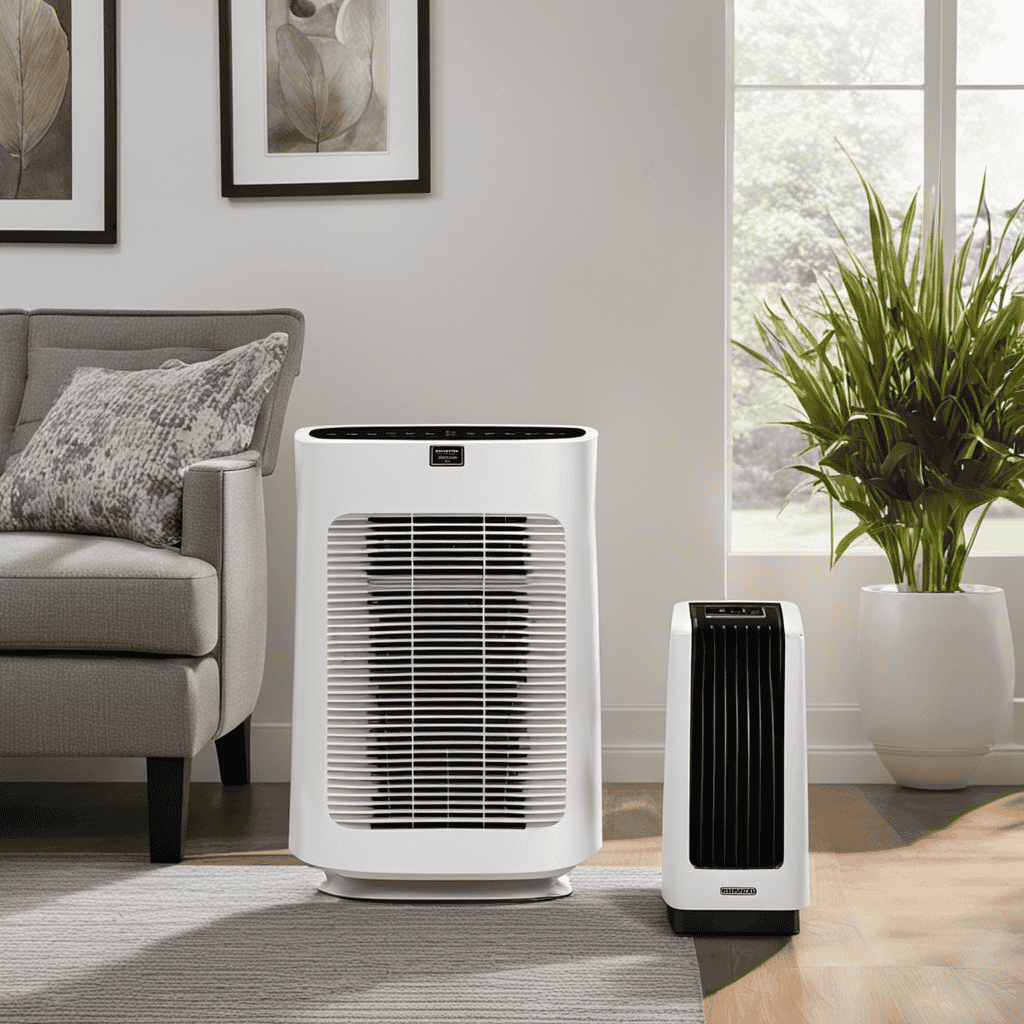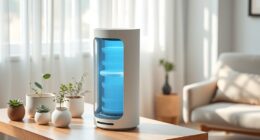Have you been aware of how the level of carbon in an air purifier carbon filter can significantly influence its performance?
As someone who is passionate about clean air and its impact on our health, I have delved into the science behind air purification.
In this article, I will explore the optimal carbon content for air purifier filters and the factors to consider when choosing the right amount.
By understanding the relationship between carbon and air purification, we can make informed decisions to ensure the air we breathe is of the highest quality.
Key Takeaways
- Carbon is essential in air purifier carbon filters as it helps trap and remove harmful pollutants from the air, improves indoor air quality, and eliminates odors.
- The optimal carbon content in air purifier filters depends on factors like efficiency and lifespan, and finding the right balance is important.
- When choosing the right amount of carbon, it is important to analyze specific air quality concerns, consider the size of the space being purified, and find a balance between thickness and airflow.
- Thicker carbon filters provide a larger surface area for pollutant adsorption, but very thick filters may result in decreased efficiency, so finding the right balance between thickness and efficiency is crucial.
The Importance of Carbon in Air Purifier Carbon Filters
Carbon is essential in air purifier carbon filters because it helps to effectively trap and remove harmful pollutants from the air. The effectiveness of carbon filtration in air purifiers is widely recognized and supported by scientific evidence.
Carbon filters work by utilizing activated carbon, a highly porous form of carbon that has the ability to adsorb various pollutants and contaminants. When air passes through the carbon filter, the activated carbon attracts and binds to these harmful substances, effectively removing them from the air.
This process not only helps to improve indoor air quality but also provides numerous benefits. Carbon filtration helps to eliminate unpleasant odors, such as those caused by smoke, pets, or cooking, creating a fresher and more pleasant environment. Additionally, carbon filters can remove volatile organic compounds (VOCs), which are chemicals that can be found in household products and have been linked to various health issues.
Overall, the inclusion of carbon in air purifier filters is crucial for their effectiveness and provides significant benefits for indoor air quality.
Determining the Optimal Carbon Content for Air Purifier Filters
To determine the optimal content for your air purifier filters, you should consider factors such as effectiveness and longevity. One important aspect to consider is the efficiency of the carbon filter in removing pollutants from the air. The higher the efficiency, the better the filter will be at trapping and removing harmful particles. Another factor to consider is the lifespan of the carbon filter. A longer lifespan means that the filter will be able to effectively purify the air for a longer period of time before needing to be replaced.
To help visualize the different carbon filter options available, I have created a table below:
| Carbon Content | Efficiency | Lifespan |
|---|---|---|
| Low | 60% | 3 months |
| Medium | 80% | 6 months |
| High | 95% | 12 months |
As you can see, the higher the carbon content, the higher the efficiency and lifespan of the filter. It’s important to find the right balance that meets your specific needs and budget.
Factors to Consider When Choosing the Right Amount of Carbon
When it comes to determining the optimal thickness of carbon filters for air purifiers, several factors should be taken into consideration.
Firstly, the specific air quality concerns of the environment in which the air purifier will be used should be analyzed. Factors such as the presence of pollutants, allergens, and volatile organic compounds (VOCs) can dictate the necessary thickness of the carbon filter.
Additionally, the size of the space being purified and the frequency of air circulation should also be taken into account to ensure the most effective filtration and optimal air quality.
Optimal Carbon Filter Thickness
The ideal thickness for an air purifier carbon filter is determined by its ability to effectively remove pollutants from the air. To achieve optimal carbon filter density, it is important to understand the relationship between carbon filter thickness and its efficiency. A thicker carbon filter provides a larger surface area for air to pass through, allowing for more contact with the carbon particles and enhancing its ability to trap pollutants. However, if the filter is too thick, it may restrict airflow and reduce the overall efficiency of the air purifier. Therefore, finding the right balance is crucial. Here is a table summarizing the relationship between carbon filter thickness and efficiency:
| Carbon Filter Thickness | Efficiency |
|---|---|
| Thin | Low |
| Moderate | Moderate |
| Thick | High |
| Very Thick | Decreased |
| Too Thick | Reduced |
Air Quality Considerations
Considering the importance of air quality, it’s crucial to find the right balance between carbon filter thickness and efficiency. The effectiveness of a carbon filter in an air purifier greatly depends on its maintenance and the amount of carbon it contains.
Here are three key considerations when it comes to carbon filter effectiveness and air purifier maintenance:
-
Regular Replacement: Carbon filters need to be replaced periodically to maintain their effectiveness. Over time, the carbon becomes saturated with pollutants and loses its ability to effectively remove them from the air. It is recommended to replace the carbon filter every 6 to 12 months, depending on the manufacturer’s guidelines.
-
Filter Thickness: The thickness of the carbon filter can impact its efficiency. Thicker carbon filters generally have a larger surface area, allowing for more effective adsorption of pollutants. However, thicker filters may also restrict airflow, reducing the air purifier’s overall performance. Finding the right balance between thickness and airflow is crucial for optimal filtration.
-
Activated Carbon Quality: The quality of the activated carbon used in the filter also affects its effectiveness. High-quality activated carbon has a larger number of pores, providing more surface area for pollutant adsorption. It is important to choose a carbon filter with high-quality activated carbon to ensure optimal air purification.
Understanding the Relationship Between Carbon and Air Purification
To fully understand how carbon affects air purification, you should know that its effectiveness depends on the type and amount of carbon used in the filter. Carbon filters are commonly used in air purifiers to remove harmful pollutants and odors from the air. The efficiency of a carbon filter is determined by its ability to adsorb and trap these contaminants. The type of carbon used, such as activated carbon or charcoal, plays a significant role in the filter’s performance. Additionally, the amount of carbon in the filter also affects its efficiency. A higher carbon content allows for greater adsorption capacity, resulting in improved air purification. However, it is important to note that carbon filters require regular maintenance to ensure optimal performance. Over time, the carbon becomes saturated and loses its effectiveness, so periodic replacement or regeneration is necessary. By understanding the relationship between carbon and air purification, we can make informed decisions when selecting and maintaining carbon filters for our air purifiers.
| Carbon Filter Efficiency | Carbon Filter Maintenance |
|---|---|
| Depends on carbon type | Regular replacement |
| Higher carbon content | Regeneration |
| Improved air purification | Ensures optimal performance |
Now that we understand the importance of carbon in air purification, let’s explore some common mistakes to avoid when selecting carbon filters for air purifiers.
Common Mistakes to Avoid When Selecting Carbon Filters for Air Purifiers
When it comes to selecting carbon filters for air purifiers, there are several key points to consider.
First and foremost, it is important to choose the proper carbon filter size for your specific needs. This will ensure maximum effectiveness in removing pollutants and odors from the air.
Additionally, understanding the difference between activated and non-activated carbon is crucial, as activated carbon has a higher surface area and is more efficient at trapping contaminants.
Lastly, it is important to be aware of the lifespan of carbon filters, as they will need to be replaced periodically to maintain optimal performance.
Proper Carbon Filter Size
Make sure your carbon filter size is appropriate for the air purifier to effectively remove pollutants. Choosing the right size is crucial for maximizing carbon filter effectiveness and ensuring clean air.
Here are three key points to consider when determining the proper carbon filter size:
-
Airflow capacity: Check the maximum airflow capacity of your air purifier and select a carbon filter that can handle that volume. A filter that is too small may restrict airflow, reducing its effectiveness in capturing pollutants.
-
Filter lifespan: Consider the recommended replacement schedule for the carbon filter. A larger filter typically has a longer lifespan, saving you money and reducing maintenance efforts.
-
Room size: Match the carbon filter size to the room size where the air purifier will be used. A filter that is too small for a large room may not effectively remove pollutants, while a filter that is too large for a small room may be unnecessary and inefficient.
Activated Vs. Non-Activated Carbon
Activated carbon is more effective at removing pollutants than non-activated carbon. This is due to its unique structure and properties, which enhance its adsorption capabilities. Activated carbon has a larger surface area and a higher number of pores, allowing it to trap and hold a greater amount of contaminants. On the other hand, non-activated carbon has a smaller surface area and fewer pores, limiting its ability to effectively capture pollutants.
To further illustrate the differences between activated and non-activated carbon, consider the following table:
| Features | Activated Carbon | Non-Activated Carbon |
|---|---|---|
| Surface Area | Large | Small |
| Number of Pores | High | Low |
| Adsorption Efficiency | High | Low |
As seen in the table, activated carbon outperforms non-activated carbon in terms of surface area, number of pores, and adsorption efficiency. These factors contribute to the superior performance of activated carbon in removing pollutants from air and water. With advancements in carbon filter technology, the longevity, efficiency, and maintenance of carbon filters have improved, making them a cost-effective solution for air purification.
Lifespan of Carbon Filters?
To ensure the longevity of your carbon filters, it’s important to regularly replace them according to the manufacturer’s recommendations. Carbon filters play a crucial role in removing airborne contaminants, such as odors, chemicals, and volatile organic compounds (VOCs).
Here are three reasons why carbon filter replacement is essential for maintaining their effectiveness:
-
Absorption capacity: Over time, carbon filters become saturated with pollutants they have absorbed. Once they reach their absorption capacity, they become less effective at removing contaminants from the air.
-
Reduced airflow: As carbon filters become clogged with trapped particles, they can restrict the airflow in your air purifier, reducing its overall efficiency and performance.
-
Bacterial growth: Overused carbon filters can become a breeding ground for bacteria and mold, potentially releasing harmful microorganisms back into the air.
Regularly replacing carbon filters is vital for ensuring optimal air purification and maintaining a healthy indoor environment.
Now, let’s explore the role of carbon in removing specific airborne contaminants.
The Role of Carbon in Removing Specific Airborne Contaminants
Carbon plays a vital role in removing specific airborne contaminants in air purifier carbon filters. These filters rely on activated carbon, a highly porous material that attracts and traps various pollutants, such as volatile organic compounds (VOCs), odors, and chemicals.
The effectiveness of carbon in air purification is well-documented, as it has the ability to adsorb these contaminants and prevent them from recirculating into the air. Numerous studies have shown that carbon filters can effectively remove harmful substances like formaldehyde, benzene, and toluene.
However, it is important to note that carbon filters have some potential drawbacks. One limitation is their finite adsorption capacity, which means they need to be replaced regularly to maintain optimal performance. Additionally, carbon filters may not be effective against certain pollutants like particulate matter and biological contaminants.
Therefore, while carbon is highly effective in removing specific airborne contaminants, it is important to consider its limitations and use it in conjunction with other filtration technologies for comprehensive air purification.
Testing and Certification Standards for Carbon Filters in Air Purifiers
When choosing an air purifier, make sure to look for testing and certification standards that ensure the effectiveness of the filters. These standards are crucial in determining the quality and reliability of the air purifier’s carbon filters.
Here are three important testing procedures and industry standards to consider:
-
CADR (Clean Air Delivery Rate): This measures the amount of clean air that an air purifier can deliver in a specific amount of time. Look for an air purifier with a higher CADR rating, as it indicates better filtration efficiency.
-
AHAM (Association of Home Appliance Manufacturers) certification: AHAM tests air purifiers for their ability to remove specific pollutants, such as smoke, dust, and pollen. Look for the AHAM seal to ensure the air purifier meets industry standards.
-
HEPA (High-Efficiency Particulate Air) certification: HEPA filters are highly effective in removing small particles from the air. Look for an air purifier with a HEPA certification to ensure efficient filtration.
Frequently Asked Questions
How Long Does a Carbon Filter Typically Last in an Air Purifier?
A carbon filter in an air purifier typically lasts between 6 to 12 months, depending on factors such as usage, air quality, and the size of the filter. Regular maintenance and replacement are crucial for optimal performance.
Can I Reuse a Carbon Filter After It Has Been Used in an Air Purifier?
I can reuse a carbon filter after it’s been used in an air purifier, but its effectiveness may be diminished. The carbon absorbs pollutants, and over time, it becomes saturated. It’s best to replace the filter for optimal air purification.
Are There Any Health Risks Associated With Using Carbon Filters in Air Purifiers?
There may be potential health risks associated with using carbon filters in air purifiers. It is important to consider the effectiveness of carbon filters in removing specific pollutants to ensure the safety of indoor air quality.
How Does the Size of the Air Purifier Affect the Amount of Carbon Needed in the Filter?
When it comes to air purifiers, the size of the device has a direct impact on the amount of carbon needed in the filter. This is because larger purifiers require more carbon to effectively remove pollutants and maintain optimal performance.
What Are Some Alternatives to Carbon Filters for Air Purifiers?
There are alternative filters for air purifiers that can be effective. Some options include HEPA filters, photocatalytic filters, and ionizers. Research shows that these alternatives can remove various pollutants from the air.
Conclusion
After analyzing the importance of carbon in air purifier carbon filters and considering factors like the optimal carbon content and the relationship between carbon and air purification, it is evident that selecting the right amount of carbon is crucial.
By avoiding common mistakes and understanding the role of carbon in removing specific airborne contaminants, one can ensure effective air purification.
Additionally, following testing and certification standards for carbon filters adds credibility to their performance.
To sum up, carbon is the key ingredient that unlocks clean and fresh air, making it an essential component in air purifiers.










